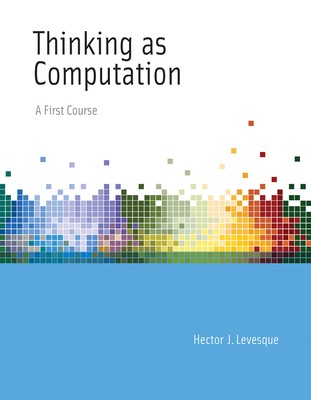
- We will send in 10–14 business days.
- Author: Hector J Levesque
- Publisher: MIT Press
- ISBN-10: 0262534746
- ISBN-13: 9780262534741
- Format: 16.8 x 22.1 x 1.5 cm, softcover
- Language: English
- SAVE -10% with code: EXTRA
Reviews
Description
Students explore the idea that thinking is a form of computation by learning to write simple computer programs for tasks that require thought.This book guides students through an exploration of the idea that thinking might be understood as a form of computation. Students make the connection between thinking and computing by learning to write computer programs for a variety of tasks that require thought, including solving puzzles, understanding natural language, recognizing objects in visual scenes, planning courses of action, and playing strategic games. The material is presented with minimal technicalities and is accessible to undergraduate students with no specialized knowledge or technical background beyond high school mathematics. Students use Prolog (without having to learn algorithms: "Prolog without tears!"), learning to express what they need as a Prolog program and letting Prolog search for answers.
After an introduction to the basic concepts, Thinking as Computation offers three chapters on Prolog, covering back-chaining, programs and queries, and how to write the sorts of Prolog programs used in the book. The book follows this with case studies of tasks that appear to require thought, then looks beyond Prolog to consider learning, explaining, and propositional reasoning. Most of the chapters conclude with short bibliographic notes and exercises. The book is based on a popular course at the University of Toronto and can be used in a variety of classroom contexts, by students ranging from first-year liberal arts undergraduates to more technically advanced computer science students.
EXTRA 10 % discount with code: EXTRA
The promotion ends in 17d.03:23:22
The discount code is valid when purchasing from 10 €. Discounts do not stack.
- Author: Hector J Levesque
- Publisher: MIT Press
- ISBN-10: 0262534746
- ISBN-13: 9780262534741
- Format: 16.8 x 22.1 x 1.5 cm, softcover
- Language: English English
This book guides students through an exploration of the idea that thinking might be understood as a form of computation. Students make the connection between thinking and computing by learning to write computer programs for a variety of tasks that require thought, including solving puzzles, understanding natural language, recognizing objects in visual scenes, planning courses of action, and playing strategic games. The material is presented with minimal technicalities and is accessible to undergraduate students with no specialized knowledge or technical background beyond high school mathematics. Students use Prolog (without having to learn algorithms: "Prolog without tears!"), learning to express what they need as a Prolog program and letting Prolog search for answers.
After an introduction to the basic concepts, Thinking as Computation offers three chapters on Prolog, covering back-chaining, programs and queries, and how to write the sorts of Prolog programs used in the book. The book follows this with case studies of tasks that appear to require thought, then looks beyond Prolog to consider learning, explaining, and propositional reasoning. Most of the chapters conclude with short bibliographic notes and exercises. The book is based on a popular course at the University of Toronto and can be used in a variety of classroom contexts, by students ranging from first-year liberal arts undergraduates to more technically advanced computer science students.


Reviews